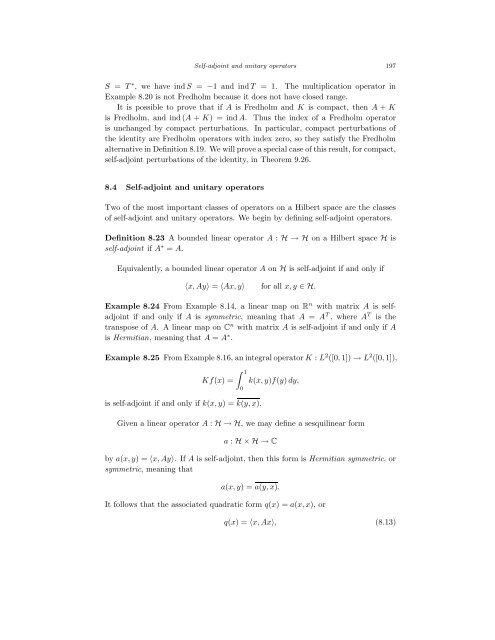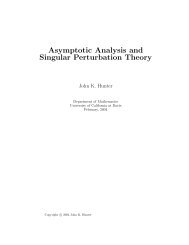Bounded Linear Operators on a Hilbert Space
Bounded Linear Operators on a Hilbert Space
Bounded Linear Operators on a Hilbert Space
Create successful ePaper yourself
Turn your PDF publications into a flip-book with our unique Google optimized e-Paper software.
Self-adjoint and unitary operators 197<br />
S = T ∗ , we have ind S = −1 and ind T = 1. The multiplicati<strong>on</strong> operator in<br />
Example 8.20 is not Fredholm because it does not have closed range.<br />
It is possible to prove that if A is Fredholm and K is compact, then A + K<br />
is Fredholm, and ind (A + K) = ind A. Thus the index of a Fredholm operator<br />
is unchanged by compact perturbati<strong>on</strong>s. In particular, compact perturbati<strong>on</strong>s of<br />
the identity are Fredholm operators with index zero, so they satisfy the Fredholm<br />
alternative in Definiti<strong>on</strong> 8.19. We will prove a special case of this result, for compact,<br />
self-adjoint perturbati<strong>on</strong>s of the identity, in Theorem 9.26.<br />
8.4 Self-adjoint and unitary operators<br />
Two of the most important classes of operators <strong>on</strong> a <strong>Hilbert</strong> space are the classes<br />
of self-adjoint and unitary operators. We begin by defining self-adjoint operators.<br />
Definiti<strong>on</strong> 8.23 A bounded linear operator A : H → H <strong>on</strong> a <strong>Hilbert</strong> space H is<br />
self-adjoint if A ∗ = A.<br />
Equivalently, a bounded linear operator A <strong>on</strong> H is self-adjoint if and <strong>on</strong>ly if<br />
〈x, Ay〉 = 〈Ax, y〉 for all x, y ∈ H.<br />
Example 8.24 From Example 8.14, a linear map <strong>on</strong> R n with matrix A is selfadjoint<br />
if and <strong>on</strong>ly if A is symmetric, meaning that A = A T , where A T is the<br />
transpose of A. A linear map <strong>on</strong> C n with matrix A is self-adjoint if and <strong>on</strong>ly if A<br />
is Hermitian, meaning that A = A ∗ .<br />
Example 8.25 From Example 8.16, an integral operator K : L2 ([0, 1]) → L2 ([0, 1]),<br />
1<br />
Kf(x) =<br />
is self-adjoint if and <strong>on</strong>ly if k(x, y) = k(y, x).<br />
0<br />
k(x, y)f(y) dy,<br />
Given a linear operator A : H → H, we may define a sesquilinear form<br />
a : H × H → C<br />
by a(x, y) = 〈x, Ay〉. If A is self-adjoint, then this form is Hermitian symmetric, or<br />
symmetric, meaning that<br />
a(x, y) = a(y, x).<br />
It follows that the associated quadratic form q(x) = a(x, x), or<br />
q(x) = 〈x, Ax〉, (8.13)
















